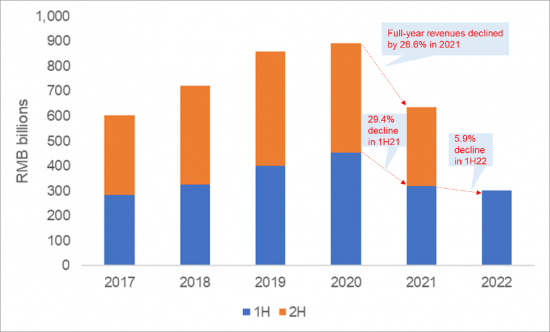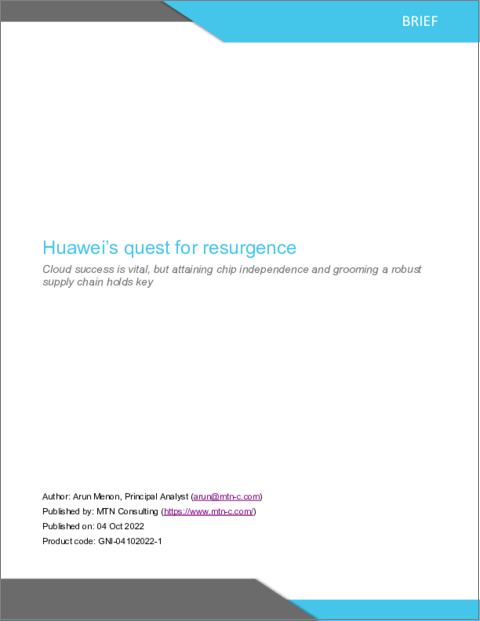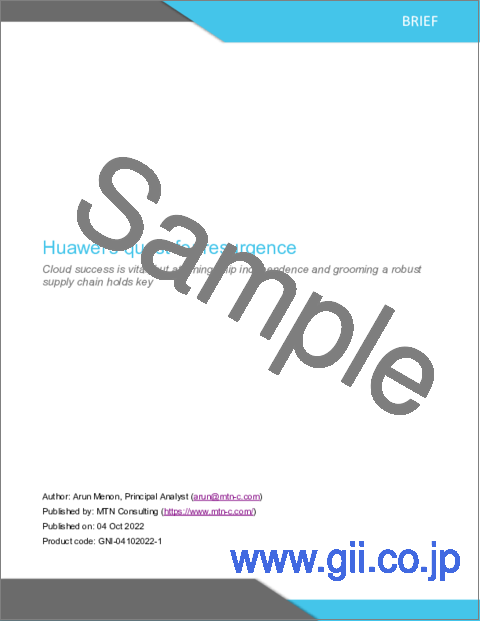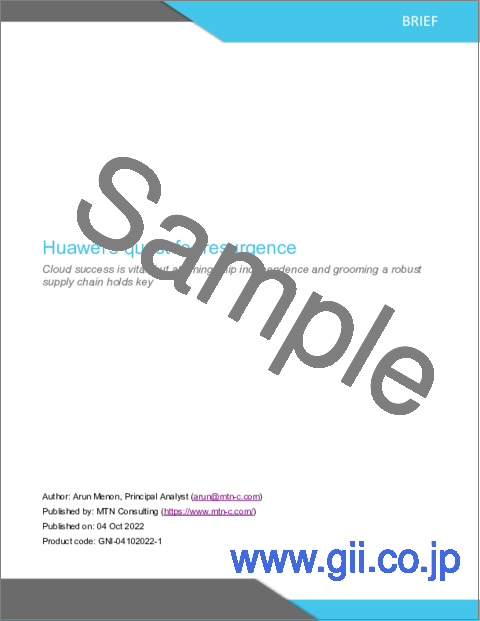|
|
市場調査レポート
商品コード
1132080
Huaweiの復活への取り組み:クラウドでの成功が不可欠だが、チップの独立性の確保と強力なサプライチェーンの構築が鍵を握るHuawei's Quest for Resurgence: Cloud Success is Vital, but Attaining Chip Independence and Grooming a Robust Supply Chain Holds Key |
||||||
| Huaweiの復活への取り組み:クラウドでの成功が不可欠だが、チップの独立性の確保と強力なサプライチェーンの構築が鍵を握る |
|
出版日: 2022年10月04日
発行: MTN Consulting, LLC
ページ情報: 英文 9 Pages
納期: 即納可能
|
- 全表示
- 概要
- 図表
- 目次
2018年に続いて2020年に再び発動された米国の制裁は、Huaweiを悩ませ続けています。同社は中低価格帯のスマートフォン部門、Honor、x86サーバー事業など、いくつかの事業ラインの売却を余儀なくされ、「至宝」ともいえる通信機器事業における世界的地位は打撃を被りました。これらの挫折により、Huaweiは2021年に28.6%という過去最大の年間収益減少を経験し、騒然となっています。2022年上半期も減収傾向は続いたもの、落ち込みのペースは大幅に鈍化しました。しかし、この間の純利益の減少を抑えるには不十分で、米国の技術抑制がもたらした厳しい経済情勢によって顧客の需要が半分以下に激減しています。
図表サンプル

現在の混乱で苦境に立たされているHuaweiは、さらなるリスクを軽減するために、クラウドとサプライチェーンの独立性に大きな賭けに出ています。クラウドへの注力は、サービスやソフトウェアに対する事業体リストの裁定による直接的な影響がないことから生まれたものです。同社はすでにクラウド分野で顕著な前進を遂げており、中国ではAlibabaに次ぐ第2位のクラウドプロバイダーとして台頭しています。中国の省政府や国有企業との取引経験を持つHuaweiのことを考えると、政府部門向けの強力なクラウドポートフォリオは大きな利点となります。もう1つの強みは、米国の制裁の影響を直接受けない市場にある、海外のクラウドデータセンターの実績です。また、Huaweiは、中国の壮大な「一帯一路構想 (BRI)」の下、世界なデジタル拡張構想「デジタルシルクロード (DSR)」に携わる重要なプレーヤーでもあります。
サプライチェーンを再構築するために、Huaweiはハードウェアとクラウド関連事業の両方を強化するために、エンドツーエンドの自社開発によるイノベーションを目指しています。同社のチップ子会社であるHiSiliconは、データセンターのサーバープロセッサやデバイス、通信ネットワーク機器用のチップを設計していますが、自社チップの製造、国内ファブとの提携、国内チップ新興企業への投資という3本柱の戦略によって、生産能力の向上を目指しています。
Huaweiが復活を遂げるには、次の2つの側面があります。
- クラウドサービス事業:ハードウェアベースの消費者部門が大きな打撃を受けたため、そのギャップを多少なりとも解消することが任務となります。
- 競合に対抗できる高度なチップへのアクセス
Huaweiは、最近発表した通信事業者向けクラウド・ソリューションや通信事業者との柔軟な連携モデルを通じて、クラウドサービスと通信機器事業とのシナジーなど、独自の提案を行うことができるため、最初の側面は達成可能だと思われます。
しかし、2つ目の点は、Huaweiにとって障害となる可能性があります。国産チップ製造によって達成される技術力は、Intel・TSMC・Samsungの持つ技術力に比べると何年も遅れているからです。先進的な製造の欠点に対する解決策が見つかるまでは、Huaweiは能力の低い国内ファブに依存し続けることになり、今後3~4年間はサバイバルモードに入ることになります。さらに、Huaweiは現在、Huawei Cloudの提供の中心となるデータセンターのサーバーチップの設計にARMに大きく依存しています。米国がARMにHuaweiとの提携を制限する方法を見出す可能性もあり、中国ベンダーはRISC-Vの代替品に頼らざるを得なくなります。
当レポートでは、Huaweiの昨今の業績動向や主な課題について調査すると共に、難局打開に向けた対応策 - クラウド事業の推進、サプライチェーンの強化など - や解決すべき問題点について考察しております。
分析範囲
当レポートの分析対象の企業・団体:
|
|
目次
- 概要
- 制裁はHuaweiの世界的地位を揺るがす
- Huaweiは全力でクラウドと十分なチップの確保に乗り出す
- Huaweiが失った魔力を取り戻す道のりは、長いものになるだろう
List of Figures
- Figure 1: Huawei's annualized share of telco network infrastructure market
- Figure 2: Huawei total revenues: Half-yearly basis, 2017-22
- Figure 3: Huawei's R&D and R&D/revenues: 2017-21
The US sanctions imposed way back in 2018, and then again in 2020, continue to haunt Huawei. The company was forced to divest some business lines- including its mid- to low-end smartphone unit, Honor, and x86 server business - and its global standing in its "crown jewel" telecom equipment business has taken a hit. These setbacks have sent Huawei into a tizzy as it reported its biggest ever annual revenue drop of 28.6% in 2021. Though the revenue downtrend continued into 1H22, the pace of drop slowed down drastically. But that wasn't enough to contain net profit decline during the period, which more than halved as a difficult economy reduced demand from customers, intensifying woes brought by the US technology curbs.
VISUALS

Hard-pressed by the current turmoil, Huawei is betting big on cloud and supply chain independence to alleviate any further risks. The cloud focus emerges from the fact that there is no direct impact from the Entity List ruling on services and software. The company is already making notable strides in the cloud space, with its emergence as the second-biggest cloud provider after Alibaba in China. Its strong cloud portfolio for the government sector is a big advantage, considering Huawei's experience working with provincial governments and state-owned enterprises in China. The other advantage is its overseas cloud data center footprint, which are in markets less directly impacted by US sanctions. Huawei is also an essential player engaged in China's global digital expansion initiative, "Digital Silk Road" (DSR), under its grand Belt and Road Initiative (BRI).
To rebuild its supply chain, Huawei is aspiring to end-to-end home-grown innovation to power both its hardware- and cloud-related businesses. While its chip subsidiary, HiSilicon, designs data center server processors and chips for devices and telecom network equipment, it is seeking to ramp up production capabilities through a three-pronged strategy: build in-house chips, partner with domestic fabs, and invest in domestic chip startups.
Huawei's efforts to stage a comeback will depend on two aspects:
- Cloud services business, which will be tasked to somewhat address the gap left by the severely hit hardware-based consumer division
- Access to advanced chips that can take on the competition
The first aspect looks achievable as Huawei will be able to offer distinctive propositions such as synergies between its cloud offering and telecom equipment business, through its recently launched telco cloud solutions, coupled with a flexible collaboration model with the telcos.
The second aspect, though, could prove to be a stumbling block for Huawei, as technological capabilities achieved through homegrown chip manufacturing are years behind the capabilities possessed by Intel, TSMC, and Samsung. Until a solution to its advanced manufacturing shortcoming is figured out, Huawei will continue to rely on less-capable domestic fabs, which will put the company in survival mode for the next 3-4 years. Further, Huawei is currently relying heavily on ARM for design of its data center server chips, which are central to the Huawei Cloud offering. There is some chance that the US will find a way to restrict ARM from working with Huawei, forcing the Chinese vendor to lean on RISC-V alternatives.
Coverage:
Companies and organizations mentioned in this report include:
|
|
Table of Contents
- Summary
- Sanctions roil Huawei's global standing
- Huawei goes full throttle on cloud, and chip sufficiency
- Huawei's journey to regain its lost mojo will be a long one




